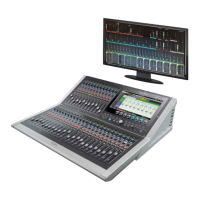
Do you have a question about the Calrec BRIO 36 and is the answer not in the manual?
| Faders | 36 |
|---|---|
| Dual layers of faders | Yes |
| Surround sound | 5.1 |
| EQ | 4-band parametric EQ |
| Dynamics | Compressor, Gate |
| Networking | Hydra2 |
| Connectivity | Ethernet |
| Power Supply | Redundant |
| Channels | 64 input channels |
Contact details for technical assistance, product warranty, repairs, and standard of service.
Important safety instructions, cleaning procedures, warning symbols, earthing, and battery replacement.
Overview of the Brio 36's simple and intuitive touchscreen interface and its main views.
Explanation of audio signal paths, inputs, outputs, and buses within the Brio 36 system.
Details on using Hydra2 patchbays for managing audio sources and destinations across the network.
Accessing and configuring general settings like analogue levels, input impedance, and meter styles.
Connecting sources and destinations, understanding ports, and making patches in the I/O screen.
Controlling input signals, including I/O box port settings and DSP channel input adjustments.
Using the four-band parametric EQ with LF/HF filters, including touch display controls and settings.
Details on Expander/Gate/Ducker and Compressor/Limiter modules, including controls and links.
Accessing monitor controls, source settings, and visual feedback from the monitor bar.
Using PFL, AFL, and Output Listen systems for summed mixes of pre/post fader path feeds.
Customizing meter layouts on the external DVI display, including slot usage and presets.
Routing microphone signals for communication, including touch display and surface buttons.
Creating comprehensive foldback mixes with automatic input removal for listeners.
Configuring buses and outputs, including Mains, Groups, Auxes, Direct Outputs, and Mix Minus.
Quick and simple steps for routing signals to buses or outputs within the Brio 36.
Configuring GPIs to respond to external signals and GPOs to control external equipment.